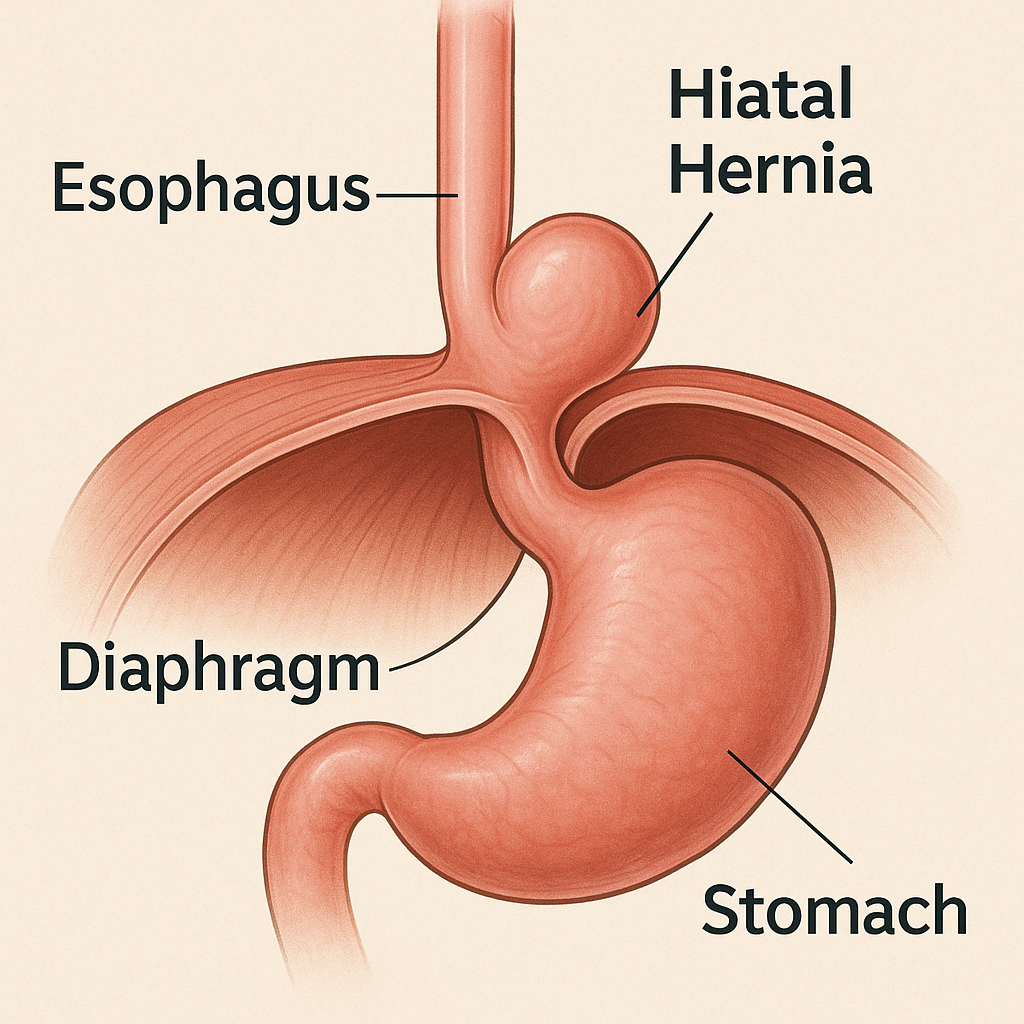Hiatal Hernia
Understanding Hiatal Hernia: Causes, Symptoms, Diagnosis, and Treatment
A hiatal hernia is a common gastrointestinal condition that occurs when part of the stomach pushes upward through the diaphragm into the chest cavity. Although many people may not realize they have it, a hiatal hernia can sometimes contribute to chronic reflux, chest discomfort, and other digestive symptoms. This essay explores the causes, risk factors, diagnosis, symptoms, and treatment options associated with hiatal hernia.
What Is a Hiatal Hernia?
The diaphragm is a large muscle separating the chest cavity from the abdomen. It contains a small opening called the hiatus, through which the esophagus passes before connecting to the stomach.
A hiatal hernia occurs when the upper portion of the stomach bulges through this opening and into the chest. There are two main types:
1. Sliding Hiatal Hernia
This is the most common type. The stomach and the lower esophageal sphincter slide up into the chest. It is often associated with gastroesophageal reflux disease (GERD).
2. Paraesophageal Hiatal Hernia
Less common but potentially more serious. The stomach pushes through the hiatus and sits beside the esophagus. This type carries the risk of stomach strangulation and may require surgery.
Causes and Risk Factors
There is no single cause of hiatal hernia, but certain factors increase the likelihood of developing one:
Structural or Lifestyle Factors
Weakening of the diaphragm with age
Increased abdominal pressure due to pregnancy, obesity, or heavy lifting
Chronic coughing or vomiting
Genetic predisposition
Smoking, which contributes to muscle weakening
Associated Medical Conditions
GERD
Connective tissue disorders such as Ehlers–Danlos syndrome
Persistent constipation (straining)
Signs and Symptoms
Not all hiatal hernias cause noticeable symptoms. Many are discovered incidentally during imaging or endoscopy. When symptoms do occur, they often resemble GERD:
Heartburn or acid reflux
Regurgitation of food or sour liquid
Difficulty swallowing
Chest or upper abdominal pain
Feeling of fullness after small meals
Shortness of breath (in larger hernias)
Chronic cough or throat irritation
Paraesophageal hernias may also cause:
Severe chest pain
Vomiting
Gastrointestinal bleeding
Signs of strangulation, which can be a medical emergency
Diagnosis
A hiatal hernia is typically diagnosed through medical imaging or digestive tract examinations:
Common Diagnostic Tests
Upper endoscopy (EGD): Allows visualization of the esophagus and stomach.
Barium swallow X-ray: Reveals the shape and position of the stomach.
Esophageal manometry: Measures esophageal muscle pressure and function.
Treatment Options
Treatment depends on the type and severity of the hernia as well as associated symptoms.
Lifestyle Modifications
These are often recommended for sliding hiatal hernias with reflux symptoms:
Weight management
Avoiding large or late meals
Reducing intake of acidic and spicy foods
Elevating the head of the bed
Avoiding alcohol and smoking
Wearing loose clothing around the abdomen
Medications
To manage GERD-related symptoms:
Antacids
H2 blockers (e.g., famotidine)
Proton pump inhibitors (e.g., omeprazole)
These do not fix the hernia itself, but they reduce acid irritation.
Surgical Treatment
Surgery is typically reserved for:
Paraesophageal hernias
Large or complicated hernias
Hernias causing severe reflux unresponsive to medication
Nissen fundoplication and hernia repair are common surgical approaches. These procedures restore the stomach to its proper position and strengthen the esophageal sphincter.
Prognosis and Living with a Hiatal Hernia
Many people live comfortably with a hiatal hernia through simple lifestyle adjustments. For others, medical therapy or surgery may be necessary to alleviate symptoms and prevent complications. Early diagnosis and proper management can significantly improve quality of life and reduce long-term digestive issues.
Conclusion
A hiatal hernia is a widespread condition that ranges from mild and symptom-free to severe and potentially dangerous. Understanding the causes, recognizing symptoms, and seeking appropriate treatment can help individuals manage this condition effectively. With proper care, most people can minimize discomfort and maintain healthy digestive function.

